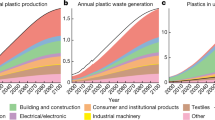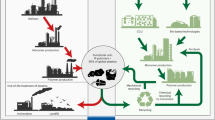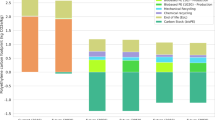Abstract
One proposed solution to the global plastic crisis is replacing conventional plastics with bio-based plastics and alternatives. Recent studies suggest that bio-based products could mitigate the impacts of plastic pollution and that carbon emissions from the plastic sector could be reduced by using biomass as a plastic feedstock. Given the scale of plastic production, the resulting increase in biomass demand could induce detrimental land-use change at the global level. We use a spatially explicit land-system model to evaluate the land-use impact of bio-based plastic replacement up to the year 2040. At the global level, mitigating both plastic pollution and carbon emissions from the plastic sector could lead to a 22% increase in cropland expansion, a 35% increase in the area of cropland undergoing intensification and a 20% increase in deforestation relative to the baseline scenario. The amount and magnitude of land-use change depend on trade, technology and how alternative products are integrated into the plastics system. Decreasing plastic demand and production may prove a less risky strategy to mitigate the impacts of plastics.
This is a preview of subscription content, access via your institution
Access options
Access Nature and 54 other Nature Portfolio journals
Get Nature+, our best-value online-access subscription
$32.99 / 30 days
cancel any time
Subscribe to this journal
Receive 12 digital issues and online access to articles
$119.00 per year
only $9.92 per issue
Buy this article
- Purchase on SpringerLink
- Instant access to full article PDF
Prices may be subject to local taxes which are calculated during checkout





Similar content being viewed by others
Data availability
The initial land-system map and modelling results, as well as land-system suitability regression results, are available via figshare at https://doi.org/10.6084/m9.figshare.25511386 (ref. 62).
Code availability
The CLUMondo model, with documentation, is available at: https://doi.org/10.34894/XZCPQY.
References
Lebreton, L. & Andrady, A. Future scenarios of global plastic waste generation and disposal. Palgrave Commun. 5, 6 (2019).
Borrelle, S. B. et al. Predicted growth in plastic waste exceeds efforts to mitigate plastic pollution. Science 369, 1515–1518 (2020).
Zheng, J. & Suh, S. Strategies to reduce the global carbon footprint of plastics. Nat. Clim. Chang. 9, 374–378 (2019).
Helm, L. T., Murphy, E. L., McGivern, A. & Borrelle, S. B. Impacts of plastic waste management strategies. Environ. Rev. https://doi.org/10.1139/er-2021-0117 (2022).
Lau, W. W. Y. et al. Evaluating scenarios toward zero plastic pollution. Science 369, 1455–1461 (2020).
Breaking the Plastic Wave: A Comprehensive Assessment of Pathways Towards Stopping Ocean Plastic Pollution (PEW Charitable Trusts & Systemiq, 2020); www.pewtrusts.org/-/media/assets/2020/07/breakingtheplasticwave_report.pdf
Song, J. H., Murphy, R. J., Narayan, R. & Davies, G. B. H. Biodegradable and compostable alternatives to conventional plastics. Philos. Trans. R. Soc. B 364, 2127–2139 (2009).
Exploring the Potential for Adopting Alternative Materials to Reduce Marine Litter (UNEP, 2018); https://wedocs.unep.org/bitstream/handle/20.500.11822/25485/plastic_alternative.pdf?sequence=1&isAllowed=y
Alfano, S., Berruti, F., Denis, N. & Santagostino, A. The future of second-generation biomass. McKinsey www.mckinsey.com/capabilities/sustainability/our-insights/the-future-of-second-generation-biomass (2016).
Brodin, M., Vallejos, M., Opedal, M. T., Area, M. C. & Chinga-Carrasco, G. Lignocellulosics as sustainable resources for production of bioplastics—a review. J. Clean. Prod. 162, 646–664 (2017).
Crippa, M et al. A Circular Economy for Plastics—Insights from Research and Innovation to Inform Policy and Funding Decisions (European Commission, 2019).
Meys, R. et al. Achieving net-zero greenhouse gas emission plastics by a circular carbon economy. Science 374, 71–76 (2021).
Stegmann, P., Daioglou, V., Londo, M., van Vuuren, D. P. & Junginger, M. Plastic futures and their CO2 emissions. Nature 612, 272–276 (2022).
Fargione, J. E., Plevin, R. J. & Hill, J. D. The ecological impact of biofuels. Annu. Rev. Ecol. Evol. Syst. 41, 351–377 (2010).
Hertel, T. W. et al. Effects of US maize ethanol on global land use and greenhouse gas emissions: estimating market-mediated responses. BioScience 60, 223–231 (2010).
Peng, L., Searchinger, T. D., Zionts, J. & Waite, R. The carbon costs of global wood harvests. Nature 620, 110–115 (2023).
Searchinger, T. et al. Use of U.S. croplands for biofuels increases greenhouse gases through emissions from land-use change. Science 319, 1238–1240 (2008).
Bishop, G., Styles, D. & Lens, P. N. L. Environmental performance comparison of bioplastics and petrochemical plastics: a review of life cycle assessment (LCA) methodological decisions. Resour. Conserv. Recycl. 168, 105451 (2021).
Escobar, N., Haddad, S., Börner, J. & Britz, W. Land use mediated GHG emissions and spillovers from increased consumption of bioplastics. Environ. Res. Lett. 13, 125005 (2018).
Helm, L. T. The Land-Use Impacts of Plastic Alternatives (Arizona State Univ., 2023).
Lambin, E. F. & Meyfroidt, P. Global land use change, economic globalization, and the looming land scarcity. Proc. Natl Acad. Sci. USA 108, 3465–3472 (2011).
Schulze, K., Malek, Ž. & Verburg, P. H. How will land degradation neutrality change future land system patterns? A scenario simulation study. Environ. Sci. Policy 124, 254–266 (2021).
van Asselen, S. & Verburg, P. H. Land cover change or land-use intensification: simulating land system change with a global-scale land change model. Glob. Chang. Biol. 19, 3648–3667 (2013).
Stehfest, E. et al. Integrated Assessment of Global Environmental Change with Image 3.0. Model Description and Policy Applications (PBL Netherlands Environmental Assessment Agency, 2014).
Van Vuuren, D. et al. The 2021 SSP Scenarios of the IMAGE 3.2 Model. Preprint at EarthArXiv https://doi.org/10.31223/X5CG92 (2021).
Jung, M. et al. Areas of global importance for conserving terrestrial biodiversity, carbon and water. Nat. Ecol. Evol. 5, 1499–1509 (2021).
Malek, Ž. & Verburg, P. H. Mapping global patterns of land use decision-making. Glob. Environ. Change 65, 102170 (2020).
Venier-Cambron, C., Helm, L. T., Malek, Ž. & Verburg, P. H. Representing justice in global land-use scenarios can align biodiversity benefits with protection from land grabbing. One Earth 7, 896–907 (2024).
Revised Draft Text of the International Legally Binding Instrument on Plastic Pollution, Including in the Marine Environment (UNEP, 2023); https://wedocs.unep.org/bitstream/handle/20.500.11822/44526/RevisedZeroDraftText.pdf
Vidal, F. et al. Designing a circular carbon and plastics economy for a sustainable future. Nature 626, 45–57 (2024).
Bachmann, M. et al. Towards circular plastics within planetary boundaries. Nat. Sustain. 6, 599–610 (2023).
Lobell, D. B., Cassman, K. G. & Field, C. B. Crop yield gaps: their importance, magnitudes, and causes. Annu. Rev. Environ. Resour. 34, 179–204 (2009).
Ray, D. K., Ramankutty, N., Mueller, N. D., West, P. C. & Foley, J. A. Recent patterns of crop yield growth and stagnation. Nat. Commun. 3, 1293 (2012).
Ray, D. K., Mueller, N. D., West, P. C. & Foley, J. A. Yield trends are insufficient to double global crop production by 2050. PLoS ONE 8, e66428 (2013).
Erisman, J. W. et al. Consequences of human modification of the global nitrogen cycle. Philos. Trans. R. Soc. B 368, 20130116 (2013).
Rasmussen, L. V. et al. Social-ecological outcomes of agricultural intensification. Nat. Sustain. 1, 275–282 (2018).
Rosegrant, M. W., Ringler, C. & Zhu, T. Water for agriculture: maintaining food security under growing scarcity. Annu. Rev. Environ. Resour. 34, 205–222 (2009).
Hillmyer, M. A. The promise of plastics from plants. Science 358, 868–870 (2017).
Rosenboom, J.-G., Langer, R. & Traverso, G. Bioplastics for a circular economy. Nat. Rev. Mater. 7, 117–137 (2022).
Raj, T., Chandrasekhar, K., Naresh Kumar, A. & Kim, S.-H. Lignocellulosic biomass as renewable feedstock for biodegradable and recyclable plastics production: a sustainable approach. Renew. Sustain. Energy Rev. 158, 112130 (2022).
ETP Clean Energy Technology Guide. IEA www.iea.org/data-and-statistics/data-tools/etp-clean-energy-technology-guide (2022).
Position of European Bioplastics: Industrial Use of Agricultural Feedstock (European Bioplastics, 2023); https://docs.european-bioplastics.org/publications/pp/EuBP_PP_Feedstock_availability.pdf
Sustainable Sourcing of Feedstocks for Bioplastics Clarifying Sustainability Aspects Around Feedstock Use for the Production of Bioplastics (TotalEnergies Corbion, 2022); www.totalenergies-corbion.com/media/ijpb1qzl/totalenergiescorbionpla_whitepaper_foodstock_1-3.pdf
Creutzig, F. et al. Bioenergy and climate change mitigation: an assessment. GCB Bioenergy 7, 916–944 (2015).
Hassan, S. S., Williams, G. A. & Jaiswal, A. K. Moving towards the second generation of lignocellulosic biorefineries in the EU: drivers, challenges, and opportunities. Renew. Sustain. Energy Rev. 101, 590–599 (2019).
Scarborough, P. et al. Vegans, vegetarians, fish-eaters and meat-eaters in the UK show discrepant environmental impacts. Nat. Food 4, 565–574 (2023).
Biopolymers: Facts and Statistics 2022 (IFBB, 2022); www.ifbb-hannover.de/files/IfBB/downloads/faltblaetter_broschueren/f+s/Biopolymers-Facts-Statistics-einseitig-2022.pdf
Nazareth, M., Marques, M. R. C., Leite, M. C. A. & Castro, Í. B. Commercial plastics claiming biodegradable status: is this also accurate for marine environments? J. Hazard. Mater. 366, 714–722 (2019).
Viera, J. S. C., Marques, M. R. C., Nazareth, M. C., Jimenez, P. C. & Castro, Í. B. On replacing single-use plastic with so-called biodegradable ones: the case with straws. Environ. Sci. Policy 106, 177–181 (2020).
Shen, M. et al. Are biodegradable plastics a promising solution to solve the global plastic pollution? Environ. Pollut. 263, 114469 (2020).
van Asselen, S. & Verburg, P. H. A land system representation for global assessments and land-use modeling. Glob. Chang. Biol. 18, 3125–3148 (2012).
Wolff, S., Schrammeijer, E. A., Schulp, C. J. E. & Verburg, P. H. Meeting global land restoration and protection targets: what would the world look like in 2050? Glob. Environ. Change 52, 259–272 (2018).
Zabel, F. Global agricultural land resources—a high resolution suitability evaluation and its perspectives until 2100 under climate change conditions (v3.0). Zenodo https://doi.org/10.5281/zenodo.5982577 (2022).
Buchhorn, M. et al. Copernicus Global Land Service: Land Cover 100m: collection 3: epoch 2019: Globe. Zenodo https://doi.org/10.5281/ZENODO.3939050 (2020).
Riahi, K. et al. The shared socioeconomic pathways and their energy, land use, and greenhouse gas emissions implications: an overview. Glob. Environ. Change 42, 153–168 (2017).
Global Plastics Outlook: Economic Drivers, Environmental Impacts and Policy Options (OECD, 2022).
Lay, J. et al. Taking Stock of the Global Land Rush: Few Development Benefits, Many Human and Environmental Risks (Centre for Development and Environment, 2021); https://landmatrix.org/documents/118/Land_Matrix_Analytical_Report_III_digital.pdf
Stegmann, P., Daioglou, V., Londo, M. & Junginger, M. The plastics integrated assessment model (PLAIA): assessing emission mitigation pathways and circular economy strategies for the plastics sector. MethodsX 9, 101666 (2022).
International Food Policy Research Institute. Global Spatially-Disaggregated Crop Production Statistics Data for 2010 Version 2.0. Harvard Dataverse https://doi.org/10.7910/DVN/PRFF8V (2019).
European Forest Sector Outlook Study (UNECE & FAO, 2005).
Forest Product Conversion Factors (FAO, ITTO and United Nations, 2020).
Helm, Levi; Venier-Cambron, Camille; Verburg, Peter (2024). The potential land-use impacts of bio-based plastics and plastic alternatives. figshare https://doi.org/10.6084/m9.figshare.25511386
Acknowledgements
We would like to thank A. Kinzig, B. Turner II and K. Dooley for their gracious comments and feedback on this work. For this study, L.T.H. was supported through internal funding at Arizona State University. Funding sources had no involvement in research design, data collection, data analysis or data interpretation, nor involvement in publication decisions.
Author information
Authors and Affiliations
Contributions
Conceptualization: L.T.H. Formal analysis: L.T.H. and C.V.-C. Investigation: L.T.H. Methodology: L.T.H., C.V.-C. and P.H.V. Resources: P.H.V. Software: P.H.V. Visualization: L.T.H. Writing—original draft: L.T.H. Writing—review and editing: L.T.H., C.V.-C. and P.H.V.
Corresponding author
Ethics declarations
Competing interests
The authors declare no competing interests.
Peer review
Peer review information
Nature Sustainability thanks Laura Rasmussen, Janis Brizga and the other, anonymous, reviewer(s) for their contribution to the peer review of this work.
Additional information
Publisher’s note Springer Nature remains neutral with regard to jurisdictional claims in published maps and institutional affiliations.
Supplementary information
Supplementary Information
Supplementary methods and model description, Supplementary Figs. 1–14 and Tables 1–8.
Rights and permissions
Springer Nature or its licensor (e.g. a society or other partner) holds exclusive rights to this article under a publishing agreement with the author(s) or other rightsholder(s); author self-archiving of the accepted manuscript version of this article is solely governed by the terms of such publishing agreement and applicable law.
About this article
Cite this article
Helm, L.T., Venier-Cambron, C. & Verburg, P.H. The potential land-use impacts of bio-based plastics and plastic alternatives. Nat Sustain 8, 190–201 (2025). https://doi.org/10.1038/s41893-024-01492-7
Received:
Accepted:
Published:
Issue date:
DOI: https://doi.org/10.1038/s41893-024-01492-7
This article is cited by
-
Health impacts of microplastic and nanoplastic exposure
Nature Medicine (2025)



